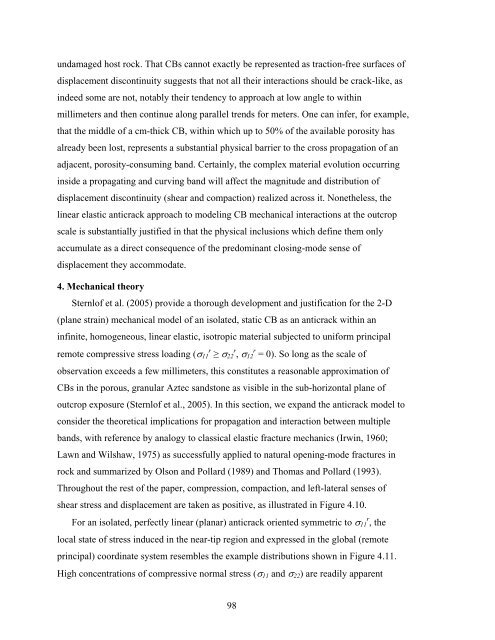structural geology, propagation mechanics and - Stanford School of ...
structural geology, propagation mechanics and - Stanford School of ...
structural geology, propagation mechanics and - Stanford School of ...
You also want an ePaper? Increase the reach of your titles
YUMPU automatically turns print PDFs into web optimized ePapers that Google loves.
undamaged host rock. That CBs cannot exactly be represented as traction-free surfaces <strong>of</strong><br />
displacement discontinuity suggests that not all their interactions should be crack-like, as<br />
indeed some are not, notably their tendency to approach at low angle to within<br />
millimeters <strong>and</strong> then continue along parallel trends for meters. One can infer, for example,<br />
that the middle <strong>of</strong> a cm-thick CB, within which up to 50% <strong>of</strong> the available porosity has<br />
already been lost, represents a substantial physical barrier to the cross <strong>propagation</strong> <strong>of</strong> an<br />
adjacent, porosity-consuming b<strong>and</strong>. Certainly, the complex material evolution occurring<br />
inside a propagating <strong>and</strong> curving b<strong>and</strong> will affect the magnitude <strong>and</strong> distribution <strong>of</strong><br />
displacement discontinuity (shear <strong>and</strong> compaction) realized across it. Nonetheless, the<br />
linear elastic anticrack approach to modeling CB mechanical interactions at the outcrop<br />
scale is substantially justified in that the physical inclusions which define them only<br />
accumulate as a direct consequence <strong>of</strong> the predominant closing-mode sense <strong>of</strong><br />
displacement they accommodate.<br />
4. Mechanical theory<br />
Sternl<strong>of</strong> et al. (2005) provide a thorough development <strong>and</strong> justification for the 2-D<br />
(plane strain) mechanical model <strong>of</strong> an isolated, static CB as an anticrack within an<br />
infinite, homogeneous, linear elastic, isotropic material subjected to uniform principal<br />
remote compressive stress loading (σ11 r ≥ σ22 r , σ12 r = 0). So long as the scale <strong>of</strong><br />
observation exceeds a few millimeters, this constitutes a reasonable approximation <strong>of</strong><br />
CBs in the porous, granular Aztec s<strong>and</strong>stone as visible in the sub-horizontal plane <strong>of</strong><br />
outcrop exposure (Sternl<strong>of</strong> et al., 2005). In this section, we exp<strong>and</strong> the anticrack model to<br />
consider the theoretical implications for <strong>propagation</strong> <strong>and</strong> interaction between multiple<br />
b<strong>and</strong>s, with reference by analogy to classical elastic fracture <strong>mechanics</strong> (Irwin, 1960;<br />
Lawn <strong>and</strong> Wilshaw, 1975) as successfully applied to natural opening-mode fractures in<br />
rock <strong>and</strong> summarized by Olson <strong>and</strong> Pollard (1989) <strong>and</strong> Thomas <strong>and</strong> Pollard (1993).<br />
Throughout the rest <strong>of</strong> the paper, compression, compaction, <strong>and</strong> left-lateral senses <strong>of</strong><br />
shear stress <strong>and</strong> displacement are taken as positive, as illustrated in Figure 4.10.<br />
For an isolated, perfectly linear (planar) anticrack oriented symmetric to σ11 r , the<br />
local state <strong>of</strong> stress induced in the near-tip region <strong>and</strong> expressed in the global (remote<br />
principal) coordinate system resembles the example distributions shown in Figure 4.11.<br />
High concentrations <strong>of</strong> compressive normal stress (σ11 <strong>and</strong> σ22) are readily apparent<br />
98
















